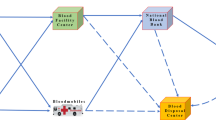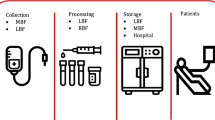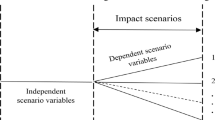Abstract
As a service-oriented supply chain, blood supply chain management deals with a human-to-human network involved with a number of direct challenges such as irregularity in both blood supply and demand as well as multiplicity of blood products, their respective lifetimes and perishability. Besides, facing risks originating from natural disasters or man-made incidents such as labor strikes, economic problems, and so on, and from uncertainty embedded in the input data is also a real highlight in designing and managing a blood supply chain network. This paper addresses an enhanced perspective incorporating a two-phase preemptive policy by which the disruption risk is diminished through a hybrid technique using the fuzzy analytic hierarchy process and grey rational analysis for determining supplementary blood facilities, to cooperate in production process and decrease interruptions. Furthermore, a p-robust formulation is presented to control the network reliability under disruption scenarios at minimum cost. To protect the network against the uncertainty, a consolidated approach based on a recently developed fuzzy measure is extended. We also examine the validity and practicality of the proposed model and its solution perspective along with the reliability of the network by a real case of Iran. It is worth nothing that the problems in the case of disasters in which the impact of the two risk streams will be felt most keenly, could benefit from the proposed procedure advantages since it develops a proactive and controlling approach which can be extensively applicable in disastrous situation.












Similar content being viewed by others
References
Abdulwahab, U., & Wahab, M. I. M. (2014). Approximate dynamic programming modeling for a typical blood platelet bank. Computers & Industrial Engineering,78, 259–270.
Alfonso, E., Augusto, V., & Xie, X. (2015). Mathematical programming models for annual and weekly bloodmobile collection planning. IEEE Transactions on Automation Science and Engineering,12(1), 96–105.
Arvan, M., Tavakkoli-Moghaddam, R., & Abdollahi, M. (2015). Designing a bi-objective and multi-product supply chain network for the supply of blood. Uncertain Supply Chain Management,3(1), 57–68.
Baghalian, A., Rezapour, S., & Farahani, R. Z. (2013). Robust supply chain network design with service level against disruptions and demand uncertainties: A real-life case. European Journal of Operational Research,227(1), 199–215.
Beliën, J., & Forcé, H. (2012). Supply chain management of blood products: A literature review. European Journal of Operational Research,217(1), 1–16.
Ben-Tal, A., Golany, B., Nemirovski, A., & Vial, J. P. (2005). Retailer-supplier flexible commitments contracts: A robust optimization approach. Manufacturing and Service Operations Management,7(3), 248–271.
Blake, J., Heddle, N., Hardy, M., & Barty, R. (2009). Simplified platelet ordering using shortage and outdate targets. International Journal of Health Management and Information,1(2), 145–166.
Cetin, E., & Sarul, L. S. (2009). A blood bank location model: A multiobjective approach. European Journal of Pure and Applied Mathematics,2(1), 112–124.
Cheraghi, S., Hosseini-Motlagh, S. M., & Ghatreh Samani, M. (2017). Integrated planning for blood platelet production: A robust optimization approach. Journal of Industrial and Systems Engineering,10, 55–80.
Dillon, M., Oliveira, F., & Abbasi, B. (2017). A two-stage stochastic programming model for inventory management in the blood supply chain. International Journal of Production Economics,187, 27–41.
Drackley, A., Newbold, K. B., Paez, A., & Heddle, N. (2012). Forecasting Ontario’s blood supply and demand. Transfusion,52(2), 366–374.
Duan, Q., & Liao, T. W. (2014). Optimization of blood supply chain with shortened shelf lives and ABO compatibility. International Journal of Production Economics,153, 113–129.
Elalouf, A., Hovav, S., Tsadikovich, D., & Yedidsion, L. (2015). Minimizing operational costs by restructuring the blood sample collection chain. Operations Research for Health Care,7, 81–93.
Ensafian, H., & Yaghoubi, S. (2017). Robust optimization model for integrated procurement, production and distribution in platelet supply chain. Transportation Research Part E: Logistics and Transportation Review,103, 32–55.
Fabozzi, F. J., Huang, D., & Zhou, G. (2010). Robust portfolios: Contributions from operations research and finance. Annals of Operations Research,176(1), 191–220.
Fahimnia, B., Jabbarzadeh, A., Ghavamifar, A., & Bell, M. (2017). Supply chain design for efficient and effective blood supply in disasters. International Journal of Production Economics,183, 700–709.
Ghandforoush, P., & Sen, T. K. (2010). A DSS to manage platelet production supply chain for regional blood centers. Decision Support Systems,50(1), 32–42.
Gunpinar, S., & Centeno, G. (2015). Stochastic integer programming models for reducing wastages and shortages of blood products at hospitals. Computers and Operations Research,54, 129–141.
Hemmelmayr, V., Doerner, K. F., Hartl, R. F., & Savelsbergh, M. W. (2010). Vendor managed inventory for environments with stochastic product usage. European Journal of Operational Research,202(3), 686–695.
Hosseinifard, Z., & Abbasi, B. (2018). The inventory centralization impacts on sustainability of the blood supply chain. Computers and Operations Research,89, 206–212.
Inuiguchi, M., & Ramık, J. (2000). Possibilistic linear programming: a brief review of fuzzy mathematical programming and a comparison with stochastic programming in portfolio selection problem. Fuzzy Sets and Systems,111(1), 3–28.
Jabbarzadeh, A., Fahimnia, B., & Seuring, S. (2014). Dynamic supply chain network design for the supply of blood in disasters: A robust model with real world application. Transportation Research Part E: Logistics and Transportation Review,70, 225–244.
Jokar, A., & Hosseini-Motlagh, S. M. (2015). Impact of capacity of mobile units on blood supply chain performance: Results from a robust analysis. International Journal of Hospital Research,4(3), 101–105.
Kamp, C., Heiden, M., Henseler, O., & Seitz, R. (2010). Management of blood supplies during an influenza pandemic. Transfusion,50(1), 231–239.
Kamyabniya, A., Lotfi, M. M., Naderpour, M., & Yih, Y. (2017). Robust platelet logistics planning in disaster relief operations under uncertainty: A coordinated approach. Information Systems Frontiers, 1–24. https://doi.org/10.1007/s10796-017-9788-5.
Khalilpourazari, S., & Khamseh, A. A. (2017). Bi-objective emergency blood supply chain network design in earthquake considering earthquake magnitude: A comprehensive study with real world application. Annals of Operations Research. https://doi.org/10.1007/s10479-017-2588.
Kleindorfer, P. R., & Saad, G. H. (2005). Managing disruption risks in supply chains. Production and operations management,14(1), 53–68.
Kohneh, J. N., Teymoury, E., & Pishvaee, M. S. (2016). Blood products supply chain design considering disaster circumstances (Case study: Earthquake disaster in Tehran). Journal of Industrial and Systems Engineering,9, 51–72.
Lee, D. H., & Dong, M. (2008). A heuristic approach to logistics network design for end-of-lease computer products recovery. Transportation Research Part E: Logistics and Transportation Review,44(3), 455–474.
Liu, B., & Iwamura, K. (1998). Chance constrained programming with fuzzy parameters. Fuzzy Sets and Systems,94(2), 227–237.
Liu, B., & Liu, Y. K. (2002). Expected value of fuzzy variable and fuzzy expected value models. IEEE Transactions on Fuzzy Systems,10(4), 445–450.
Lowalekar, H., & Ravichandran, N. (2010). Model for blood collections management. Transfusion,50(12), 2778–2784.
Mousazadeh, M., Torabi, S. A., Pishvaee, M. S., & Abolhassani, F. (2018). Health service network design: A robust possibilistic approach. International Transactions in Operational Research,25(1), 337–373.
Nagurney, A., Masoumi, A. H., & Yu, M. (2012). Supply chain network operations management of a blood banking system with cost and risk minimization. Computational Management Science,9(2), 205–231.
Osorio, A. F., Brailsford, S. C., & Smith, H. K. (2015). A structured review of quantitative models in the blood supply chain: A taxonomic framework for decision-making. International Journal of Production Research,53(24), 7191–7212.
Peng, P., Snyder, L. V., Lim, A., & Liu, Z. (2011). Reliable logistics networks design with facility disruptions. Transportation Research Part B: Methodological,45(8), 1190–1211.
Pishvaee, M. S., Rabbani, M., & Torabi, S. A. (2011). A robust optimization approach to closed-loop supply chain network design under uncertainty. Applied Mathematical Modelling,35(2), 637–649.
Puranam, K., Novak, D. C., Lucas, M. T., & Fung, M. (2017). Managing blood inventory with multiple independent sources of supply. European Journal of Operational Research,259(2), 500–511.
Ramezanian, R., & Behboodi, Z. (2017). Blood supply chain network design under uncertainties in supply and demand considering social aspects. Transportation Research Part E: Logistics and Transportation Review,104, 69–82.
Şahinyazan, F. G., Kara, B. Y., & Taner, M. R. (2015). Selective vehicle routing for a mobile blood donation system. European Journal of Operational Research,245(1), 22–34.
Salehi, F., Mahootchi, M., & Husseini, S. M. M. (2017). Developing a robust stochastic model for designing a blood supply chain network in a crisis: A possible earthquake in Tehran. Annals of Operations Research, 1–25. https://doi.org/10.1007/s10479-017-2533-0.
Samani, M. R. G., Torabi, S. A., & Hosseini-Motlagh, S. M. (2018). Integrated blood supply chain planning for disaster relief. International Journal of Disaster Risk Reduction,27, 168–188.
Samvedi, A., Jain, V., & Chan, F. T. (2012). An integrated approach for machine tool selection using fuzzy analytical hierarchy process and grey relational analysis. International Journal of Production Research,50(12), 3211–3221.
Seifried, E., Klueter, H., Weidmann, C., Staudenmaier, T., Schrezenmeier, H., Henschler, R., et al. (2011). How much blood is needed? Vox Sanguinis,100(1), 10–21.
Sha, Y., & Huang, J. (2012). The multi-period location-allocation problem of engineering emergency blood supply systems. Systems Engineering Procedia,5, 21–28.
Shishebori, D., & Babadi, A. Y. (2015). Robust and reliable medical services network design under uncertain environment and system disruptions. Transportation Research Part E: Logistics and Transportation Review,77, 268–288.
Shishebori, D., Snyder, L. V., & Jabalameli, M. S. (2014). A reliable budget-constrained FL/ND problem with unreliable facilities. Networks and Spatial Economics,14(3–4), 549–580.
Snyder, L. V., & Daskin, M. S. (2006). Stochastic p-robust location problems. IIE Transactions,38(11), 971–985.
Snyder, L. V., Scaparra, M. P., Daskin, M. S., & Church, R. L. (2006). Planning for disruptions in supply chain networks. Tutorials in operations research,2, 234–257.
Tang, C. S. (2006). Robust strategies for mitigating supply chain disruptions. International Journal of Logistics: Research and Applications,9(1), 33–45.
Xu, J., & Zhou, X. (2013). Approximation based fuzzy multi-objective models with expected objectives and chance constraints: Application to earth-rock work allocation. Information Sciences,238, 75–95.
Yahyaei, M., & Bozorgi-Amiri, A. (2018). Robust reliable humanitarian relief network design: an integration of shelter and supply facility location. Annals of Operations Research, 1–20. https://doi.org/10.1007/s10479-018-2758-6.
Zahiri, B., & Pishvaee, M. S. (2017). Blood supply chain network design considering blood group compatibility under uncertainty. International Journal of Production Research,55(7), 2013–2033.
Zahiri, B., Torabi, S. A., Mousazadeh, M., & Mansouri, S. A. (2015). Blood collection management: Methodology and application. Applied Mathematical Modelling,39(23–24), 7680–7696.
Zokaee, S., Jabbarzadeh, A., Fahimnia, B., & Sadjadi, S. J. (2017). Robust supply chain network design: An optimization model with real world application. Annals of Operations Research,257(1–2), 15–44.
Author information
Authors and Affiliations
Corresponding author
Rights and permissions
About this article
Cite this article
Samani, M.R.G., Hosseini-Motlagh, SM. An enhanced procedure for managing blood supply chain under disruptions and uncertainties. Ann Oper Res 283, 1413–1462 (2019). https://doi.org/10.1007/s10479-018-2873-4
Published:
Issue Date:
DOI: https://doi.org/10.1007/s10479-018-2873-4




